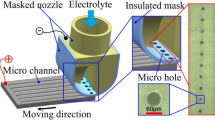Abstract
A micro slit die easily manufactured using a micro electrical discharge machining (MEDM) is proposed for micro heat sink fabrication. In the investigations described in this paper, processed concave and rectangular shaped copper foils were combined piece by piece to form an assembled electrode. This electrode was used to fabricate a micro slit die. This die included 15 micro fins in a small tungsten carbide plate. The micro heat sink was made by applying a pressing or scraping method when the micro slit die was used. The experiments showed that debris, produced by the MEDM, might cause a discharge concentration effect because of the narrow gaps between the workpiece and electrode. Parts of the micro fin were seriously melted during this process. Flushing dielectric could effectively remove the debris from the narrow gap, generating an appropriate discharge dispersing effect. However, the discharge effect was unstable when large flushing pressure was applied, thus reducing the machining precision. The micro fins were formed into a rectangular shape using kerosene as the MEDM dielectric. Using distilled water as the MEDM dielectric produced a higher material removal rate and serious assembled electrode wear. Therefore, the micro fins formed as triangle profiles. The micro heat sink was higher even when the pressing method was used. The heat sink deviated and was full of burrs on the fin edge when the scraping method was used.
Similar content being viewed by others
References
Rettemayr M, Exner HE, Mader W (1988) Electron microscopy of binder phase deformation in WC-Co alloys. Mater Sci Technol 4(11):984–990
Liu AY, Wentzcovitch RM, Cohen ML (1988) Structural and electronic properties of WC. Phys Rev B Condens Matter 38(14):9483–9489
Levy GN, Wertheim R (1988) EDM machining of sintered carbide compacting dies. Ann CIRP 37(1):175–178
Pandit SM, Rajukar KP (1981) Analysis of electrical discharge machining of cemented carbides. Ann CIRP 30(1):111–116
Gadalla AM, Tsai W (1989) Machining of WC-Co composites. Mater Manuf Process 4(3):411–423
Gadalla AM, Tasi W (1989) Electrical discharge machining of tungsten carbide cobalt composites. J Amer Ceram Soc 72(8):1396–1401
Ramulu M, Garbini JL (1991) EDM surface characterization of a ceramic composite TiB2-Sic. J Eng Mater Technol 113(10):437–442
Cheng YM, Eubank PT, Gadalla AM (1996) Electrical discharge machining of ZrB2-based ceramics. Mater Manuf Process 11(4):565–574
Masuzawa T (1985) An approach to micromachining through machine tool technology. Ann CIRP 34(1):419–425
Masuzawa T, Fujino M, Kobayashi K, Suzuki T (1985) Wire electro-discharge grinding for micro-machining. Ann CIRP 34(1):431–434
Kagaya K, Oishi Y, Yada K (1986) Micro-electro-discharge machining using water as a working fluid-1: micro-hole drilling. Precis Eng 8(3):156–162
Masuzawa T, Yamamoto M, Fujino M (1989) A micropunching system using wire-EDM. Proc of Int Symposium for Electromachining (ISEM-9), pp 86–89
Kagaya K, Oishi Y, Yada K (1990) Micro-electro-discharge machining using water as a working fluid-2: narrow slit fabrication. Precis Eng 12(4):213–217
Kuo L, Masuzawa T (1991) A micro-pipe fabrication process. Proc IEEE MEMS’91, pp 80–85
Allen DM, Lecheheb A (1996) Micro electro-discharge machining of ink jet nozzles: optimum selection of material and machining parameters. J Mater Process Technol 58:53–66
Xi-Qing S, Masuzawa T, Fjino M (1996) Micro ultrasonic machining and its applications in MEMS. Sens Actuators A 57:159–164
Reynaerts D, Heeren P-H, Van Brussel H (1997) Microstructuring of silicon by elelctro-discharge machining (EDM). Part I: theory. Sens Actuators A 60:212–218
Chow HM, Yang CT, Yan BH, Huang FY (1999) Fabrication of micro electrode of carbide and micro hole machining characteristic of Ti-6Al-4V alloy by electrical discharge machining. J Inst Light Met 49(1):2–7
Masuzawa T (2000) State of the art of micromachining. Ann CIRP 49(2):473–488
Masuzawa T (2001) Micro-EDM. Proceedings of the 13th International Symposium for Electromachining ISEM VIII 1; pp 3–19
Yu ZY, Rajurkar KP, Shen H (2002) High aspect ratio and complex shaped blind micro holes by micro EDM. Ann CIRP 51(1):359–362
Kunieda M, Furuoya S (1991) Improvement of EDM efficiency by supplying oxygen gas into gap. Ann CIRP 40:215–218
Author information
Authors and Affiliations
Corresponding author
Rights and permissions
About this article
Cite this article
Wang, A., Yan, B., Tang, Y. et al. The feasibility study on a fabricated micro slit die using micro EDM. AMT 25, 10–16 (2005). https://doi.org/10.1007/s00170-003-1831-7
Received:
Accepted:
Published:
Issue Date:
DOI: https://doi.org/10.1007/s00170-003-1831-7




